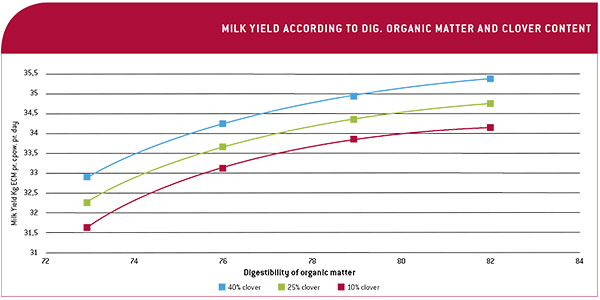Improve meat and milk yields with DLF Fiber Energy varieties
To boost your milk and meat production – by cow or by hectare – choose grass varieties bearing the DLF Fiber Energy label. DLF Fiber Energy varieties perform better because they're highly digestible. Your cattle derive more energy and protein from consuming a kilogram of a highly digestible variety than they would from a kilogram of a less digestible one.
Another advantage of DLF Fiber Energy varieties is self-sufficiency. You don't need to add as much protein to your feed if your cattle can obtain more of it from your own farm-grown grass. That makes each kilogram of milk cheaper to produce, and at the same time reduces climatic impact due to less import of soya.
Examples of highly digestible, yield-raising varieties include Redding, Iguana, Kufuga, Jaran, Gabor and Storm.
Choose high digestibility for a higher feed intake

A grass cell. The content of the cell is highly digestible; the cell wall, much less so. Improving the digestibility of the cell wall improves the digestibility of the entire grass cell.
Grass varieties with highly digestible cell walls increase the overall digestibility of each mouthful of grass. They give you a higher feed intake and therefore more milk from each kilogram of grass your cattle eat. The graph below shows how each step you take to improve digestibility raises your daily milk yields. The three curves represent different percentages of clover in the feed.

The message is clear: raising your feed intake improves your farm finances. It makes you more self-sufficient in terms of protein and energy. By growing grass that's more digestible and with a higher protein content, you win twice: you increase your milk yields and you save money on imported feed.
Comparing rations: better performance with high digestibility and high protein levels
The chart below shows how increases in digestibility and protein percentage work together to raise milk yields and lower input costs. The chart compares two conventional rations, both with a high percentage of grass in the ration. In the first, the digestibility is 74% and the protein content is 13%; in the second the digestibility has increased to 79% and the protein content has gone up to 17%. The two rations are balanced on energy, nutrients and rumen capacity. The milk price used in the calculations is 32 Eurocent per kg of ECM. Note that the calculations do not include the effect of clover on feed uptake and performance.
The outcome of this change – a higher milk yield and a lower feed cost – raises farm revenues.
|
Ration 1 |
Ration 2 |
|
| Pr. cow pr. day | Pr. cow pr. day | |
| Expected milk yield – kg ECM | 41,8 | 43,0 |
| Clover-grass silage – kg DM | 8,9 | 10,0 |
| Maize silage – kg DM | 4,0 | 4,0 |
| Concentrate, in total – kg DM | 13,4 | 12,3 |
| Cost of feed – Euro | 5,02 | 4,81 |
| Milk sales less cost of feed – Euro | 8,36 | 8,95 |
Ration 2 outperforms Ration 1 by 215 Euros per year per cow ((8,95 − 8,36) × 365 days) when working within the feed parameters specified above.
For milking cows, if your aim is a high grass intake, you should be growing clover-grass within an organic matter digestibility range of 78% to 80%.
DLF Fiber Energy has an additional benefit for grazing herds. The energy needed for meat and milk production comes primarily from the grass's cell walls and cell protein, less so from its sugars. When a high proportion of sugar is easily digested in the rumen, it's followed by a rapid decline in rumen pH. If the cow is exposed to a low rumen pH for a longer time, it will develop acidosis.
The digestibility of grass cell walls varies widely between species and varieties. At DLF, we make it easy for you to spot the difference. We mark grass varieties providing above-average digestibility with our DLF Fiber Energy label of quality.
See all our DLF Fiber Energy varieties here, or talk to your local DLF representative if you'd like some one-to-one advice.
